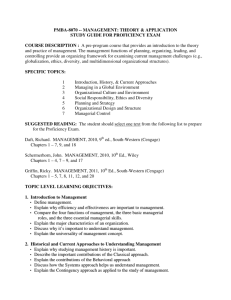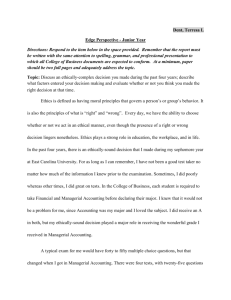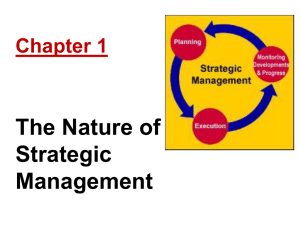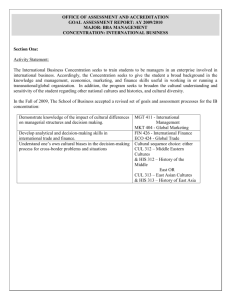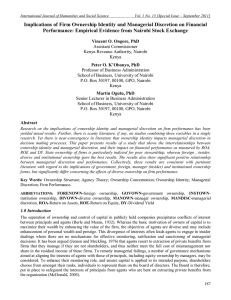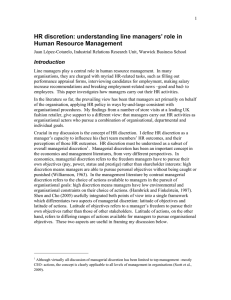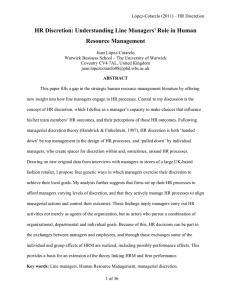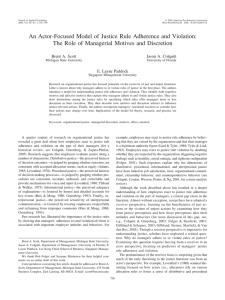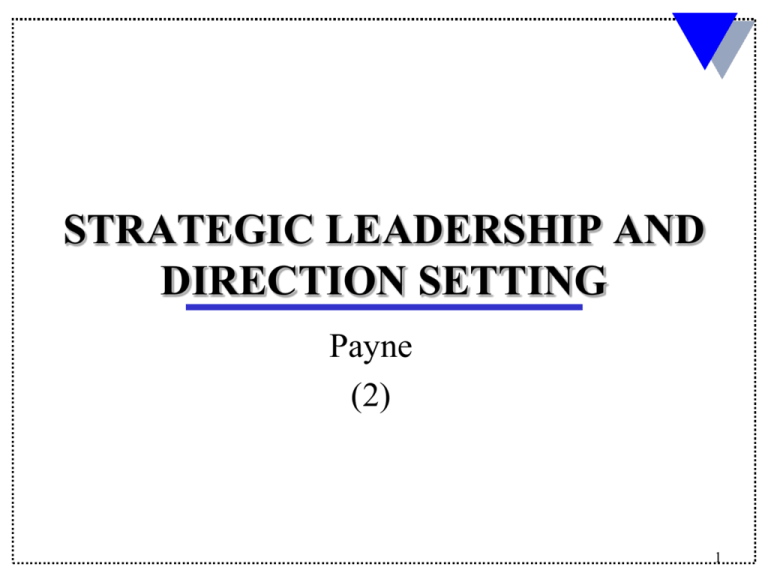
STRATEGIC LEADERSHIP AND
DIRECTION SETTING
Payne
(2)
1
Strategic Leadership
• Strategic Leadership is:
– “the ability to anticipate, envision, maintain flexibility
and empower others to create strategic change as
necessary” or
– “the process of transforming organizations from what
they are to what the leader would have them become.”
• Leaders (top managers) have four main tasks:
Define the vision/mission or role of the organization.
Develop the organization’s integrity (ethics, culture & values).
Designing the appropriate strategy and structure (the “content”)
to achieve success, and
Oversee the implementation process for bringing about change
in the organization (the “process”).
2
Leadership is Different than Management
• Leadership is closely related to “referent” power because
it is based on personal qualities of the leader and his or
her ability to elicit followers to action.
Leadership extends beyond what power is allocated to a
position in an organization or even that power that is claimed
by a member of an organization…it is attributed to someone by
others.
Leaders (top) have three main tasks:
Define the vision/mission or role of the organization.
Develop the organization’s integrity (ethics, culture &
values).
Designing the appropriate strategy and structure to achieve
success.
3
Managers and Leaders
Personality
Dimension
Manager
Leader
Impersonal, passive,
Personal, active, goals arise
Attitudes
toward goals functional; goals arise out of from desire, imagination
necessity, reality
Conceptions Combines people, ideas,
things; seeks moderate risk
of work
Looks for fresh approaches to
old problems; seeks high risk
Relationships Prefers to work with others;
with others avoids close relationships
Comfortable in solitary work;
encourages close relationships,
not averse to conflict
and conflicts
Sense of self Accepts life as it is;
unquestioning
Questions life; struggles for
sense of order
SOURCE: Reprinted by permission of Harvard Business Review. From A. Zaleznik, “Managers and Leaders: Are They
Different?” Harvard Business Review 55 (1977): 67-77. Copyright © 1977 by the Harvard Business School Publishing
Corporation; all rights reserved.
4
Strategic Leadership and the Strategic
Management Process
Strategic
Leadership
shapes the formulation of
Strategic Intent
Strategic Mission
and
influences
Strategic Actions
5
Factors Affecting Managerial Discretion
External Environment
External Environment
• Industry structure
• Rate of market growth
• Number and type of
competitors
• Nature and degree of
political/legal constraints
• Degree to which products
can be differentiated
6
Factors Affecting Managerial Discretion
External Environment
Characteristics of the
Organization
Characteristics of the Organization
• Size
• Age
• Culture
• Availability of resources
• Patterns of interaction among
employees
7
Factors Affecting Managerial Discretion
External Environment
Characteristics of the
Organization
Managerial
Discretion
Characteristics of the Manager
• Tolerance for ambiguity
• Commitment to the firm and
its desired strategic outcomes
• Interpersonal skills
• Aspiration level
• Degree of self-confidence
Characteristics of the
Manager
8
Effective Strategic Leadership
Establishing
balanced
organizational
controls
Determining
strategic
direction
Exploiting and
maintaining
core
competencies
Strategic
Leadership
Emphasizing
ethical
practice
Sustaining
an effective
organizational
culture
Developing
human
capital
9
Determining Strategic Direction
• Strategic direction means the development of a
long-term vision of a firm’s strategic intent
• It is important not to lose sight of the strengths
of the organization when making changes
required by a new strategic direction
• Executives must structure the firm effectively to
help achieve the vision
10
What is a Vision?
•
“An articulation of what the company wishes to become
or where it seeks to go” or, “the firm’s aspirations of
what it really wants to be…designed to capture the
imagination of the firm’s people and galvanize their
efforts to achieve a higher purpose.”
•
Visions often describe organizations in a lofty, even
romantic or mystical tone.
11
Strategic Vision
Characteristics:
•
Should be inspiring
• Clear, challenging, and about excellence
• Sensible, flexible and long-term
• Stable
• Gives a sense of direction
• Prepares for the future while honoring the past
The Power of a well-conceived strategic vision:
Guides managerial decision-making
Arouses employee buy-in and commitment
Prepares a company for the future
12
Examples: Strategic Visions
• BIOGEN: “We dedicate ourselves daily to improving
the lives of people around the world.”
• Disneyland: “To be the happiest place on earth.”
• Wells Fargo: “We want to satisfy all of our
customers’ financial needs and help them succeed
financially.”
• “TENET will distinguish itself as a leader in
redefining health care delivery and will be recognized
for the passion of its people and partners in providing
quality, innovative care to the patients it serves in
each community.”
13
What is a Mission?
• Grant: “A mission statement is more a statement
of corporate purpose, and often defines the area of
business in which it competes.”
• Or, “Describes the firm or organization in terms of
its business. Mission statements answer the
questions, ‘What business are we in?’ and ‘What
do we intend to do to succeed?’ …[they] are more
concrete than visions, but still do not specify the
goals and objectives necessary to translate the
mission into reality.”
14
Mission Statements
• Encompasses both the purpose of the company as well as the
basis of competition and competitive advantage.
• More specific and focused than the vision.
• Employees are the most important audience for mission
statements.
• Changes much more often than vision statements.
Example: Anheuser-Busch
Our vision: Through all of our products, services and
relationships, we will add to life's enjoyment.
Our mission:
•Be the world's beer company
•Enrich and entertain a global audience
•Deliver superior returns to our shareholders
15
Core Value Proposition (CVP) (Hardy, 2005)
• Provides a starting point for business planning and/or
innovative business development.
• Developed through 5 “Value Drivers” and related questions:
1. IDEA: What does your service or product do for
customers?
2. BENEFIT: What benefit does your product or service
provide to customers (above and beyond competitors or
substitutes)?
3. TARGET: Who are your key customers? How can they be
identified and reached?
4. PERCEPTION: How do you want to be perceived by
customers, employees and other stakeholders?
5. REWARD: What is in it for you, your employees, and
stockholders?
16
Value Statements
Values are the things organizations and people stand for or the
fundamental principles that, along with the mission, make an
organization unique. Usually associated with ethical behavior and
social responsibility.
McDonald’s Corporate Responsibility
Corporate responsibility is an important part of McDonald’s heritage. We have a
long track record of industry leadership in community involvement,
environmental protection, diversity, opportunity, and work with our suppliers to
help improve their practices. We are committed to do still more to earn the trust
of our customers and everyone else affected by our business.
McDonald's Balanced, Active Lifestyles Initiatives
McDonald’s cares about the well-being issues that are so important to many of
our customers. With our balanced, active lifestyles initiatives, we are offering a
variety of high-quality menu options, promoting physical activity, and providing
information and education to help our customers around the world make smart
choices for themselves and their families.
17
Values:
•
•
•
•
•
Our business is preserving and improving human life. All of our actions must be
measured by our success in achieving this goal. We value, above all, our ability to
serve everyone who can benefit from the appropriate use of our products and services,
thereby providing lasting consumer satisfaction.
We are committed to the highest standards of ethics and integrity. We are
responsible to our customers, to Merck employees and their families, to the
environments we inhabit, and to the societies we serve worldwide. In discharging our
responsibilities, we do not take professional or ethical shortcuts. Our interactions with
all segments of society must reflect the high standards we profess.
We are dedicated to the highest level of scientific excellence and commit our
research to improving human and animal health and the quality of life. We strive
to identify the most critical needs of consumers and customers, and we devote our
resources to meeting those needs.
We expect profits, but only from work that satisfies customer needs and benefits
humanity. Our ability to meet our responsibilities depends on maintaining a financial
position that invites investment in leading-edge research and that makes possible
effective delivery of research results.
We recognize that the ability to excel -- to most competitively meet society's and
customers' needs -- depends on the integrity, knowledge, imagination, skill,
diversity and teamwork of our employees, and we value these qualities most
highly. To this end, we strive to create an environment of mutual respect,
encouragement and teamwork -- an environment that rewards commitment and
performance and is responsive to the needs of our employees and their families.
18
Goals & Objectives
• Follows Vision & Mission to more specifically give
direction and goals for the organization. These also
serve to determine if appropriate control is been set
for strategic decisions:
Represent
commitment to achieve specific
performance targets by a certain time.
Must
be stated in quantifiable terms and contain a
deadline for achievement.
Spell-out
how much of what kind of performance
by when.
19
Types of Objectives (Controls) Required
Financial Objectives
Strategic Objectives
Outcomes focused on
Outcomes focused on
improving a firm’s
improving a firm’s
financial performance. competitiveness and its
long-term business
position.
Every company needs both strategic and
financial objectives!
20
Examples: Financial Objectives
• Increase sales growth 6 to 8 percent and accelerate core net
earnings per share growth to 13 to 15 percent in each of the next
five years (P&G)
• Generate Internet-related revenue of $1.5 billion (Automation)
• Cut overhead costs by $30 million per year (Fortune Brands)
Examples: Strategic (Non-financial) Objectives
• Capitalize on e-commerce (FedEx)
• We want a majority of our customers,when surveyed, to say they
consider us the best financial institution in the community (Wells
Fargo)
• We want to operate 6,000 stores by 2010—up from 3000 in the
year 2000 (Walgreen’s)
21
Strategic vs Financial Objectives
•
Pressures for better short-term (~1 yr) financial
performance become pronounced when
–
–
–
•
Firm is struggling financially
Resource commitments for new strategic initiatives may
hurt bottom-line for several years
Proposed strategic moves are risky
A firm that consistently passes up opportunities
to strengthen its long-term (3-5 yrs) competitive
position
–
–
–
Risks diluting its competitiveness
Risks losing momentum in its markets
Can hurt its ability to fend off rivals’ challenges
22
Setting Objectives
Birnbaum (2004) suggests a 3-step process:
1. Decide
on the essence of the objective (e.g.,
profitability, product quality, absenteeism).
- These should be specific to the organization...the
“Key Performance Indicators” and tied to Key Success
Factors
2. Decide
on the formula to measure the objective (e.g.,
annual profit as % of sales, # of product defects, ratio
of hours missed to total employee hours).
3. Quantify
(outcome and timeframe) the objectives.
(Ask yourself what matters most? How do we track it?)
23
Objectives Are Needed at All Levels
Process is top-down, not bottom-up!
1. First, establish organization-wide objectives
2. Next, set business and product line objectives
3. Then, establish functional and departmental
objectives
4. Individual objectives come last
Objective-setting needs to be more of a top-down than a bottomup process in order to guide lower-level managers and
organizational units toward outcomes that support the
achievement of overall business and company objectives.
24


